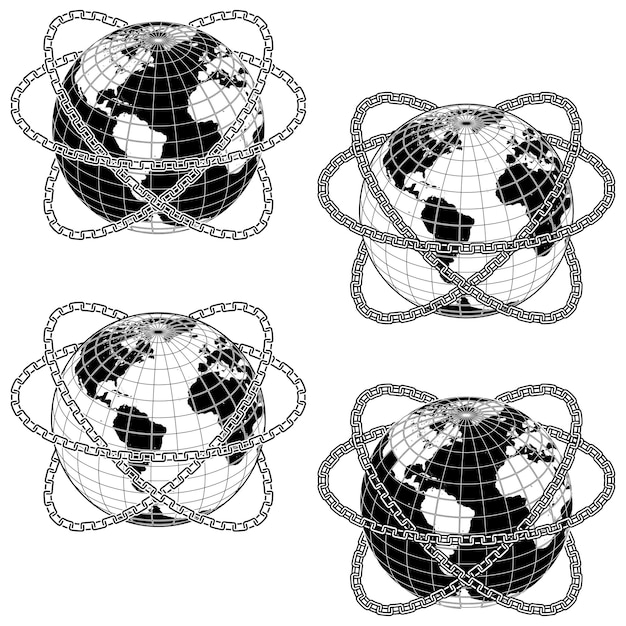US Trade Agreements: Impact on Exports Unveiled

Updated trade agreements significantly reshape the landscape for United States exports by altering tariffs, non-tariff barriers, intellectual property protections, and regulatory frameworks, directly influencing market access, competitiveness, and strategic global positioning for American businesses.
Understanding the ever-evolving dynamics of global commerce is critical for any nation, especially one as intertwined with the world economy as the United States. Today, we delve into Understanding the Impact of the Updated Trade Agreements on US Exports, a complex yet vital topic shaping the future of American businesses. These agreements, far from being static documents, are living instruments that constantly redefine the rules of international trade, directly influencing how and where U.S. goods and services flow across borders. Grasping their nuances is key to navigating the global marketplace successfully.
The Evolution of US Trade Policy and its Foundational Principles
The arc of U.S. trade policy has been one of continuous adaptation, driven by a complex interplay of economic interests, geopolitical shifts, and domestic priorities. From the post-World War II push for multilateralism embodied by the General Agreement on Tariffs and Trade (GATT) to the proliferation of bilateral and regional pacts, each era has left an indelible mark on how the United States engages with the global economy. These foundational principles – reciprocity, non-discrimination, and transparency – have largely guided U.S. negotiators, even as their application has varied.
Initially, the focus was primarily on reducing tariffs, seen as the most direct impediment to trade. However, as the world economy grew more sophisticated, so too did the trade agenda. Non-tariff barriers, such as quotas, subsidies, and overly burdensome regulations, began to receive increased attention. The realization dawned that simply cutting tariffs was insufficient if other, more subtle forms of protectionism remained unchecked. This expanded scope reflects a deeper understanding of what truly facilitates or obstructs international commerce.
From GATT to Contemporary Agreements: A Shifting Landscape
The progression from GATT to the World Trade Organization (WTO) marked a significant institutionalization of global trade rules, bringing dispute settlement mechanisms and expanding the remit to include services and intellectual property. However, the slow pace of multilateral negotiations and the rise of regional trading blocs led many nations, including the U.S., to pursue more agile bilateral and regional agreements. These deals, often touted as “WTO-plus” agreements, frequently go beyond existing WTO commitments, particularly in areas like digital trade, labor, and environmental standards.
- Shifting focus from purely tariff reduction to comprehensive regulatory alignment.
- Increased emphasis on digital trade, data flows, and e-commerce rules.
- Integration of labor and environmental provisions into core agreement texts.
- Development of stronger intellectual property protection mechanisms globally.
These contemporary agreements reflect a growing recognition that commerce is not just about goods crossing borders. It’s about the entire ecosystem of business, from protecting patents to ensuring fair labor practices and mitigating environmental impact. The U.S. approach often seeks to enshrine high standards in these areas, aiming to level the playing field and promote practices consistent with American values, potentially influencing other nations to adopt similar norms. This holistic perspective is fundamental to understanding the breadth of impact these agreements wield.
In essence, the evolution of U.S. trade policy is a dynamic narrative of responding to global economic realities while attempting to shape them. The foundational principles remain, but their implementation through updated agreements demonstrates a clear intent to address modern challenges, from climate change to the complexities of the digital economy. This continuous refinement ensures that trade policy remains a relevant and powerful tool in advancing U.S. economic interests abroad.

Key Provisions of Recent Trade Agreements Affecting US Exports
Recent trade agreements signed or updated by the United States are not monolithic; they are intricate documents, each with specific provisions designed to address particular facets of international commerce. Their collective impact on U.S. exports stems from a few recurring themes: market access, regulatory alignment, intellectual property rights, and dispute resolution mechanisms. These form the bedrock upon which American businesses can thrive or face new challenges in foreign markets.
Market access provisions are often the most direct and publicly discussed components. These typically involve tariff reductions or eliminations for specific goods, making U.S. products more competitively priced in destination markets. Beyond tariffs, agreements often tackle non-tariff barriers, such as cumbersome customs procedures, restrictive import licenses, or domestic content requirements. Streamlining these processes can be as crucial as tariff cuts, often unlocking significant new export opportunities by reducing logistical hurdles and compliance costs for American companies.
Market Access and Tariff Adjustments
The most tangible impact of trade agreements comes through modifications to tariffs. Lowering or eliminating tariffs on U.S. goods allows them to be sold at more competitive prices abroad, directly increasing their appeal to foreign buyers. This is particularly beneficial for sectors where U.S. producers have a comparative advantage but face high import duties. However, the effect isn’t uniformly positive; some domestic industries may face increased competition from imports if their own tariffs are lowered. The goal is to strike a balance that maximizes overall economic benefit.
- Elimination or reduction of duties on agricultural products, benefiting U.S. farmers.
- Tariff advantages for manufactured goods, such as machinery and automotive parts.
- Specific quota adjustments for sensitive products, balancing trade liberalization with domestic protection.
Furthermore, these agreements often include provisions that facilitate services trade, a critical and growing component of the U.S. economy. This can mean allowing U.S. service providers, such as financial firms, IT companies, or architectural practices, easier access to foreign markets by reducing licensing requirements or ensuring national treatment. The goal is to ensure that American expertise and innovation in services can be exported as freely as physical goods, driving economic growth and creating high-value jobs.
Regulatory Coherence and Non-Tariff Barriers
Beyond tariffs, modern trade agreements increasingly focus on regulatory coherence. This involves the harmonization or mutual recognition of standards and regulations between trading partners. For U.S. exporters, navigating different and often redundant regulatory frameworks in multiple countries can be a significant burden. When agreements pave the way for a single set of standards or mutual acceptance of each other’s certifications, it dramatically reduces compliance costs and accelerates market entry for American goods, from pharmaceuticals to electronic devices.
For example, if a U.S. manufacturer can certify its product once to an internationally recognized standard that is accepted in all partner countries, rather than undergoing separate and costly certification processes in each market, the efficiency gains are enormous. This level of regulatory alignment is often more complex to negotiate than tariff cuts, as it touches upon national sovereignty and domestic policy choices, but its potential to unlock trade is immense. It allows U.S. businesses to focus on innovation and production rather than navigating a labyrinth of disparate rules.
- Streamlining customs procedures to reduce delays and administrative burdens.
- Harmonization of product safety and environmental standards, simplifying compliance.
- Mutual recognition of professional licenses and certifications for services.
These detailed provisions, whether addressing market access directly or fostering regulatory alignment, collectively define the operational environment for U.S. exporters. Their careful negotiation and effective implementation are paramount to unlocking new opportunities and ensuring a competitive edge for American products and services in the global arena. The devil, as always, is in the details, and the benefits often accrue to those businesses that can best understand and leverage these intricate new rules.
Sector-Specific Analysis: Winners and Losers in the Export Arena
The impact of updated trade agreements is rarely uniform across all sectors of the U.S. economy. While some industries may see significant boosts in their export capabilities, others might face new competitive pressures or require substantial adaptation. This sector-specific analysis reveals a nuanced picture, illustrating how different parts of the American economic engine respond to changes in global trade rules. Understanding these differential effects is crucial for policymakers and businesses alike, enabling targeted strategies and mitigation efforts.
The agricultural sector, for instance, often stands to gain considerably from tariff reductions and the opening of new markets. Many U.S. agricultural products, such as soybeans, corn, and various meats, are highly competitive on the global stage but frequently face high import duties or restrictive quotas in potential markets. When these barriers are lowered or eliminated through trade agreements, American farmers and agribusinesses can expand their export volumes, leading to increased revenue and potentially greater employment in rural areas. However, this also means facing more intense competition from imported agricultural goods, requiring producers to focus on efficiency and quality.
Agriculture and Food Exports: Cultivating New Markets
For U.S. agriculture, updated trade agreements typically mean improved access to foreign markets through lower tariffs and reduced non-tariff barriers. When countries agree to reduce their duties on U.S. farm products, it directly makes American crops and livestock more affordable and appealing to foreign consumers and food processors. This has been a consistent objective of U.S. trade policy, reflecting the strength and export potential of American agriculture. The emphasis is often on ensuring predictable access and addressing phytosanitary barriers that can otherwise impede trade.
- Increased demand for U.S. beef, pork, and poultry in Asian markets due to tariff cuts.
- Expansion of grain and oilseed exports to regions with food security concerns.
- Challenges from increased competition in specific domestic agricultural product markets.
Conversely, some manufacturing sectors, especially those in mature industries that rely heavily on traditional production methods, might face heightened competition. While agreements may open export opportunities, they also typically reduce barriers to imports. This can expose domestic manufacturers to more intense price competition from foreign producers, compelling them to innovate, specialize, or relocate production to remain viable. The effects can be particularly pronounced in sectors where labor costs constitute a significant portion of the production value.
Manufacturing and Technology: Adapting to Global Competition
In manufacturing, the picture is often more mixed. Agreements can open up new export opportunities for high-value U.S. manufactured goods, especially those incorporating advanced technology or specialized components. However, they also expose domestic manufacturers to increased import competition, particularly from countries with lower labor costs or different regulatory environments. This necessitates continuous innovation, adoption of advanced manufacturing techniques, and a focus on niche markets where U.S. companies maintain a competitive edge. The emphasis shifts from mass production to specialized, high-tech exports.
For the technology sector, trade agreements are increasingly critical for issues beyond tariffs. Protecting intellectual property rights (IPR) is paramount, as is ensuring free data flows across borders. Agreements that strengthen IPR enforcement and prevent forced technology transfers are vital for U.S. tech companies that rely on innovation and proprietary knowledge. Similarly, provisions that prevent data localization requirements or facilitate cross-border data transfer are essential for cloud services, e-commerce, and other digital industries. Without these protections, the competitive advantage of U.S. tech firms can be severely undermined.
- Enhanced intellectual property protections for software, pharmaceuticals, and entertainment.
- New regulatory frameworks for digital trade, including cross-border data flows.
- Potential challenges for traditional manufacturing sectors facing import competition.
The service sector, often overlooked in traditional trade discussions focusing on goods, is another significant beneficiary. Agreements that facilitate the movement of professionals, recognize professional qualifications, and reduce restrictions on cross-border service provision are crucial for U.S. service exports, from finance and legal services to education and healthcare. Given the U.S. leads in many service industries, these provisions unlock substantial growth potential. Ultimately, the winners are often those sectors that can leverage U.S. strengths in innovation, technology, and specialized services, while “losers” may need to adapt through modernization or diversification.
Challenges and Opportunities for US Exporters in the New Landscape
The updated trade agreements present a dual-edged sword for U.S. exporters, offering both significant opportunities and formidable challenges. Navigating this evolving landscape requires strategic foresight, adaptability, and a deep understanding of the new rules of engagement. For many businesses, particularly small and medium-sized enterprises (SMEs), the complexities of international trade can be overwhelming, even with more favorable agreements in place. Therefore, identifying and addressing these challenges is as important as recognizing the potential gains.
One of the primary opportunities lies in expanded market access. With reduced tariffs and non-tariff barriers, U.S. products and services become more competitive in foreign markets, potentially leading to increased sales and market share. This is particularly beneficial for sectors that have historically faced significant protectionist measures abroad. Moreover, for businesses that have not previously engaged in exporting, these agreements can lower the entry barriers, making international trade a more viable option. Increased transparency and predictability in trade rules also reduce risk, encouraging more companies to consider exporting as a growth strategy.
Overcoming Supply Chain Disruptions and Reshoring Decisions
Recent global events have highlighted the fragility of extended supply chains. Updated trade agreements increasingly include provisions aimed at enhancing supply chain resilience, such as streamlining customs procedures or promoting diversified sourcing. For U.S. exporters, this means navigating a global environment where both efficiency and security are prioritized. Some companies are exploring reshoring or nearshoring options to reduce risks, but this can impact cost structures and, consequently, export competitiveness. Balancing these factors is a complex ongoing challenge that trade agreements aim to alleviate with clearer rules and greater predictability.
- Increased focus on diversifying supplier networks to mitigate risks.
- Potential incentives and regulatory support for reshoring key manufacturing.
- Challenges in maintaining cost-effectiveness while enhancing supply chain resilience.
However, challenges persist. Increased foreign competition in domestic markets can be a significant concern for some U.S. industries, requiring constant innovation and efficiency improvements to maintain competitiveness. Furthermore, the administrative burden of understanding and complying with new rules of origin can be substantial. Even with reduced tariffs, if a product does not meet the specified origin requirements, it may not qualify for the preferential rates, costing exporters time and money. Adapting to evolving digital trade rules, including data localization and privacy regulations in various countries, also presents a complex hurdle for tech and service exporters.
Navigating Digital Trade Rules and Data Localization
The digital economy is rapidly transforming global trade, but it also introduces new complexities, particularly around data governance. Many countries are implementing data localization requirements, demanding that data be stored and processed within their borders. This creates significant challenges for U.S. tech companies and service providers that rely on seamless, cross-border data flows. Updated trade agreements are attempting to address this by promoting free data flow provisions and prohibiting forced localization, but negotiations are often contentious. U.S. exporters must remain vigilant about these evolving digital trade rules to avoid disruptions to their business models and maintain access to critical markets.
Moreover, the enforcement of intellectual property rights remains a persistent challenge. While agreements typically include stronger IPR protections, the effectiveness of enforcement can vary significantly from one jurisdiction to another. U.S. exporters, particularly those in innovative sectors, must remain vigilant in protecting their patents, trademarks, and copyrights abroad. This often requires legal counsel and proactive measures to prevent infringement and counterfeiting, which can otherwise erode profitability and competitive advantage. The new agreements aim to provide robust frameworks, but proactive adherence to these rules in practice remains critical for businesses.
Ultimately, the new landscape demands a proactive and informed approach. Exporters must meticulously analyze the specific provisions relevant to their industries, seek expert advice on compliance, and continually monitor global trade developments. Those who can effectively leverage the new market access opportunities while mitigating the competitive and regulatory challenges will be best positioned to succeed and expand their reach in the global marketplace. This involves not just understanding policy but also making agile business decisions in a rapidly changing environment.
The Role of Government Support and Private Sector Adaptation
For U.S. exporters to fully capitalize on the opportunities presented by updated trade agreements, a synergistic effort between government support mechanisms and proactive private sector adaptation is essential. Government agencies play a crucial role in disseminating information, providing assistance, and advocating for American interests abroad. Meanwhile, businesses must be agile, innovative, and willing to invest in new strategies to navigate the complexities and leverage the advantages of the evolving trade landscape. Neither can succeed in isolation.
Government support takes many forms, from trade promotion missions and export financing to direct technical assistance. Agencies like the U.S. Department of Commerce, the Small Business Administration (SBA), and the Export-Import Bank of the United States offer a range of services designed to help American companies, particularly SMEs, overcome the hurdles of international trade. This includes market research, identification of potential buyers, and assistance with trade finance. Such support is vital for businesses that lack the internal resources to navigate complex foreign markets independently. Moreover, government can engage in advocacy to remove non-tariff barriers or address unfair trade practices, creating a more level playing field.
Government Initiatives to Boost Export Competitiveness
The U.S. government implements various programs aimed at bolstering the competitiveness of American exporters. These initiatives often focus on providing resources, expertise, and financial tools to businesses looking to enter or expand in foreign markets. Such support is particularly valuable for small and medium-sized enterprises (SMEs) that may not have the in-house capacity to navigate the complexities of international trade. These programs help bridge the knowledge gap and reduce the financial risks associated with exporting, making global markets more accessible. The goal is to ensure that the benefits of trade agreements translate into tangible growth for businesses of all sizes.
- Export finance and credit insurance programs through the Export-Import Bank (EXIM).
- Market entry assistance and matchmaking services provided by the U.S. Commercial Service.
- Trade missions and promotional events organized by the Department of Commerce.
On the private sector side, adaptation is key. Businesses must invest in understanding the intricacies of each new agreement, including rules of origin, customs procedures, and specific regulatory changes relevant to their products or services. This may involve hiring new talent with expertise in international trade, investing in compliance software, or participating in training programs offered by trade associations or government agencies. Companies should also re-evaluate their supply chains, diversify their customer base, and explore new markets that may have become more accessible due to the agreements. Innovation in product design, pricing strategies, and marketing approaches is also critical to capitalize on new export opportunities.
Private Sector Strategies for Leveraging Trade Agreements
For businesses, effectively leveraging updated trade agreements requires a proactive and strategic approach. This involves more than just identifying new markets; it demands a deep dive into the specific provisions of each agreement and how they can be translated into competitive advantages. Companies need to assess their current operations, understand their cost structures, and identify where particular agreements can offer tangible benefits, whether through tariff concessions, streamlined customs, or enhanced intellectual property protection. This strategic internal analysis is crucial for transforming policy into profit.
Furthermore, building robust international relationships and understanding cultural nuances are paramount. Successful exporting is not merely about sending goods across a border; it’s about establishing trust, fulfilling local market needs, and adapting business practices to fit foreign contexts. Trade agreements provide the framework, but individual company efforts in market research, localization of products, and cultivating strong distributor networks are what ultimately drive success. This proactive engagement, coupled with government support, forms the bedrock of a successful export strategy in the dynamic global trade environment, ensuring that the U.S. remains a competitive force.
- Conducting thorough market research to identify high-potential export destinations.
- Investing in compliance training for new rules of origin and regulatory standards.
- Developing new product lines or adapting existing ones for foreign market preferences.
The synergy between government support and private sector adaptation ensures that the U.S. remains a formidable player in the global economy, consistently expanding its export footprint. Without robust government initiatives to facilitate trade and a receptive, adaptable private sector, the full potential of updated trade agreements would remain unrealized.

Looking Ahead: Future Trends in US Export Landscape
The U.S. export landscape is in a state of perpetual evolution, heavily influenced by global economic forces, technological advancements, and shifting geopolitical priorities. As we look ahead, several key trends are poised to shape the future of American exports, demanding further adaptation of trade agreements and business strategies. Understanding these trends is crucial for maintaining and enhancing U.S. competitiveness in the global marketplace, ensuring that future policies anticipate rather than merely react to changes.
One significant trend is the accelerating pace of digitalization across all aspects of trade. E-commerce continues to grow exponentially, and digital platforms are increasingly facilitating cross-border transactions, even for small businesses. This necessitates trade agreements that effectively address issues like data governance, cyber security, and digital trade facilitation. Countries that can establish clear, modern rules for the digital economy will have a distinct advantage in future trade. For U.S. exporters, this means continually investing in digital infrastructure and understanding the specific digital trade provisions that apply to their operations, ensuring frictionless online transactions.
The Rise of Digital Trade and Green Trade Initiatives
The future of global trade is undeniably digital. E-commerce platforms, cloud computing, and real-time data exchange are transforming how goods and services are bought and sold internationally. Trade agreements are increasingly focused on establishing rules for digital trade, including provisions on cross-border data flows, consumer protection in online transactions, and preventing data localization mandates. For U.S. exporters, embracing digital tools and understanding these evolving rules will be critical to staying competitive. Simultaneously, there’s a growing emphasis on green trade, promoting environmentally sustainable goods and services and incorporating climate considerations into trade policies. This signals a shift toward trade that is not only efficient but also responsible.
- Increased emphasis on sustainability and environmental provisions in trade pacts.
- Development of common standards for green products and renewable energy technologies.
- Challenges in balancing environmental goals with economic competitiveness.
Another major trend is the growing emphasis on “green trade” and sustainability. As climate change concerns intensify, trade policies are increasingly likely to incorporate environmental standards and promote trade in environmentally friendly goods and services. For U.S. exporters, this could mean new opportunities in renewable energy technologies, sustainable manufacturing practices, and environmental services. However, it also implies new compliance requirements related to carbon footprints, ethical sourcing, and circular economy principles. Future agreements may feature carbon border adjustments or other mechanisms to incentivize sustainable production, affecting the cost and competitiveness of various exports.
Geopolitical Shifts and Supply Chain Resiliency
Geopolitical shifts and the push for greater supply chain resilience are also transforming the export landscape. Recent global events have underscored the vulnerabilities of highly centralized supply chains, prompting countries to consider diversification and, in some cases, “reshoring” or “friend-shoring” critical production. While this may lead to some shifts in where goods are manufactured and sourced, it also creates new opportunities for U.S. manufacturers to re-establish domestic production capabilities and export higher-value components or finished goods. Future trade agreements may increasingly focus on promoting diversified and secure supply networks, potentially driving investment into strategic industries within the U.S. While the full impact of these shifts remains to be seen, they represent a significant force that exporters must monitor closely.
Lastly, regionalization versus multilateralism will continue to be a defining tension. While the WTO faces challenges in reaching new multilateral agreements, regional trading blocs and bilateral deals are likely to proliferate. U.S. exporters will need to navigate this fragmented landscape, understanding the specific advantages and disadvantages of each agreement. The ability to leverage preferential access through targeted regional agreements while adapting to broader multilateral principles will be a hallmark of successful export strategies in the coming years. This nuanced approach will be vital for maintaining a strong global footprint for U.S. products and services, adapting to new norms, and capitalizing on emerging consumer demands in diverse markets. Ultimately, the future demands agility, foresight, and a commitment to continuous adaptation across sectors.
| Key Aspect | Brief Description |
|---|---|
| 📈 Market Access | Tariff cuts and non-tariff barrier reductions enhance U.S. product competitiveness abroad. |
| 🛡️ IP Protection | Stronger enforcement of intellectual property rights safeguards U.S. innovation. |
| 💡 Regulatory Alignment | Harmonizing standards simplifies compliance for U.S. goods and services. |
| 🌍 Digital Trade Rules | New provisions for data flows and e-commerce facilitate tech and service exports. |
FAQs on Updated Trade Agreements and US Exports
▼
Updated trade agreements primarily affect export costs by reducing or eliminating tariffs imposed by importing countries. Lower tariffs mean U.S. goods become more competitively priced in foreign markets, potentially increasing sales volume. Additionally, agreements can streamline customs procedures and reduce non-tariff barriers, leading to lower logistical and compliance costs for exporters, ultimately making U.S. products more attractive globally.
▼
Intellectual property rights (IPR) are crucial in modern trade agreements for U.S. companies, especially in innovation-driven sectors like technology and pharmaceuticals. Stronger IPR protections within agreements safeguard patents, trademarks, and copyrights, preventing counterfeiting and unauthorized use of U.S. innovations abroad. This ensures that American companies can competitively export their valuable intellectual assets without fear of widespread appropriation, fostering continued investment in research and development.
▼
Non-tariff barriers, such as burdensome regulatory requirements, quotas, or differing product standards, can significantly impede U.S. exports even after tariffs are reduced. These barriers increase compliance costs, delay market entry, and often require separate product modifications or certifications for each market. Updated trade agreements aim to align or mutually recognize regulations, thereby streamlining processes and making it easier for U.S. companies to navigate foreign markets, often proving as beneficial as tariff cuts.
▼
Typically, U.S. sectors that are highly competitive globally but face significant foreign barriers tend to benefit most from new trade agreements. Agriculture, with its high output and efficiency, frequently sees increased market access through tariff reductions. Technology and services sectors benefit from stronger intellectual property protections and provisions for digital trade and cross-border data flows. Advanced manufacturing, particularly in specialized goods, also gains from streamlined regulatory processes.
▼
Beyond traditional trade barriers, U.S. exporters should anticipate the increasing importance of digital trade rules, including data privacy and localization. Green trade initiatives, focusing on environmental standards and carbon footprints, will also become critical. Furthermore, geopolitical shifts influence supply chain resilience and the trend towards “friend-shoring” or domestic production incentives. Companies must adapt by investing in digital infrastructure, sustainable practices, and more diversified supply chains to stay competitive in a dynamically evolving global marketplace.
Conclusion
The journey of understanding the impact of the updated trade agreements on US exports reveals a landscape of continuous transformation. These agreements are not static, but rather dynamic instruments that redefine America’s economic relationships worldwide. From the intricate web of tariff reductions and regulatory alignments to the nuanced sector-specific implications and the burgeoning influence of digital and green trade, the future of U.S. exports hinges on a careful navigation of these evolving rules. Success demands unwavering vigilance, strategic adaptation from the private sector, and robust support from government entities. Ultimately, those U.S. businesses that proactively embrace these changes, leveraging new opportunities while mitigating challenges, will undoubtedly lead the way in shaping the next chapter of American global commerce, driving innovation and prosperity.





